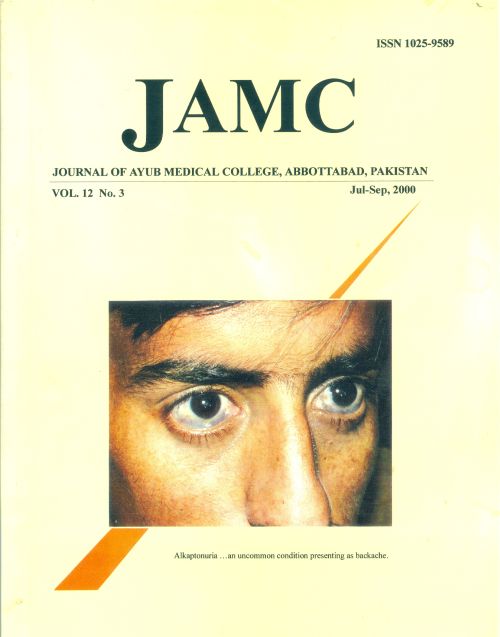Du PHENOTYPE - A REVIEW
Abstract
Du is the phenotypic term used to denote a weakened expression of the D antigen. Du originally defined as those redcells reacting with anti-D only when a more sensitive indirect antiglobulin test was used. Du phenotype can arise fromthree different genetic situations, a) A person may inherit a gene coding for weakened quantitative expression of Duantigen, b) One gene may interact with another to modify and weaken the expression of the D antigen, c) A gene maynot code for the total material that makes up the antigen. The frequency of D'1 antigen is relatively low less than 1%.D" is a poor immunogen, however, accelerated destruction of Du red cells can result if transfused to a person alreadymaking anti-D. Hence Du donor units are currently labelled as Rah positive. Du recipients are labelled as Rah negative.Newborn of Rah negative mother is tested for D & Du and Rh Ig is recommended for mothers of D positive or Dupositive infants in order to prevent potential immunisation. The terms Du variant or partial D'; are recommended whenthere is both a qualitative and quantitative difference noted in the D antigen.References
Anstee DJ. Blood group antigens defined by amino acid
sequences of red cell surface proteins. Transfuse Med.
Beckers EAM, Faas BHW, Lightar P et al.
Characterisation of the hybrid RHD gene leading to the
partial D category 111c phenotype. Transfusion 1996;
: 567-74.
Christenson M, Brenme K, Shanwell A, Westgren M
and Christenson B. Flow Cytometric quantitation of
serum anti-D in pregnancy. Transfusion 1996; 36: 500-
Hung CH. The human Rh 50 glycoprotein gene
structural organization and associated splicing defect
resulting in Rh (nul 11) disease J Biol Chem 1998; 273:
-2213.
Bryant. .An introduction to immunohematology, 3rd
Ed. 1994.
Colin Y. Baya CZ, Cardine, Virginal, Huffel VV and
Carton JP. Genetic basis of the RhD positive and RhD
negative blood group polymorphism as determined by
Southern analysis. Blood 1991; 78:’2747-52.
Jones JW, Finning K, Mattock R et al. The serologic
profile and molecular basis of a new partial D
phenotype DHR. Sang 1997; 73: 252-56.
Agree et al. Molecular biology- of the Rh antigens.
Blood 1991: 78: 551-63.
Bush M, Sabo B, Stroup M and Masouredis P. Red cell
D antigen sites and titration scores in a family with
weak and normal D “phenotypes inherited from a
homozygous Du mother. Transfusion 1974; 14:433-39.
Cunningham NA, Zola AP. Hui HL, Taylar LM and
Green FA. Binding characteristics of anti Rho(D)
antibodies to Rho(D) positive and Dured cells. Blood
: 66: 765-68.
Gunson and Smith. The depressant effect of the Cde
(R1) chromosome on the Du antigen. Von Sang 1967;
: 423-30.
Mollison. Blood Traasfusion in Clinical Medicine. 9th
Ed. Oxford: Blackwell Scientific Publications, 1993;
-69.
Jones J, Scott N, Boab D. Monoclonal anti-D
specificity and RhD structure criteria for selection of
monoclonal anti-D reagents for routine typing of
patients and donors. Trans Med 1995: 5: 171-84.
Tippett and Sanger. Observations on subdivisions of
the Rh antigen D. Vox Sang 1962; 7: 9-13.
Lacey et al. Fatal hemolytic disease of a new born due
to anti-D in a Rh Positive Du variant mother.
Transfusion 1993; 23: 91- 94.
Linker OA. Blood transfusion in current medical
diagnosis and treatment. 38th Ed. Appleton and Lange,
; 535-36.
Roctina E and Jones NCII. The use of purified 1120
labelled anti-r-celobulin in the determination of the
number of D antigen sites on red cells of different
phenotypes. Vose Sang 1965; 10: 675-86.
Wager FF., Gasser C, Mueller TH., Schnauzer D,
Schooner F, Flagella WA. Three molecular structures
cause Rhinos D category' VI phenotypes with distinct
immunohematologic features. Blood 1998; 91: 2157-
Contreras and Knight. The Rh negative donor. Clin Lab
Haemat. 1989; 11: 317-22.
Contreras M. Controversies in transfusion medicine
testing for D": CON Tras Med. 1990
Issue
Section
License
Journal of Ayub Medical College, Abbottabad is an OPEN ACCESS JOURNAL which means that all content is FREELY available without charge to all users whether registered with the journal or not. The work published by J Ayub Med Coll Abbottabad is licensed and distributed under the creative commons License CC BY ND Attribution-NoDerivs. Material printed in this journal is OPEN to access, and are FREE for use in academic and research work with proper citation. J Ayub Med Coll Abbottabad accepts only original material for publication with the understanding that except for abstracts, no part of the data has been published or will be submitted for publication elsewhere before appearing in J Ayub Med Coll Abbottabad. The Editorial Board of J Ayub Med Coll Abbottabad makes every effort to ensure the accuracy and authenticity of material printed in J Ayub Med Coll Abbottabad. However, conclusions and statements expressed are views of the authors and do not reflect the opinion/policy of J Ayub Med Coll Abbottabad or the Editorial Board.
USERS are allowed to read, download, copy, distribute, print, search, or link to the full texts of the articles, or use them for any other lawful purpose, without asking prior permission from the publisher or the author. This is in accordance with the BOAI definition of open access.
AUTHORS retain the rights of free downloading/unlimited e-print of full text and sharing/disseminating the article without any restriction, by any means including twitter, scholarly collaboration networks such as ResearchGate, Academia.eu, and social media sites such as Twitter, LinkedIn, Google Scholar and any other professional or academic networking site.









